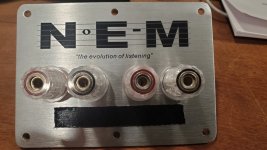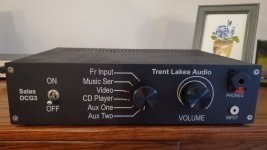Many methods being advanced here and all are potentially good options. I say potentially because I'm not sure EXACTLY what Joel is trying to create and on what medium and what degree of detail (size) he is looking for. He does say his budget is around $500 to produce clean looking lettering at home. That last statement leaves out going to sign shops (he wants to do it at home) or purchasing $6,000 printers.
Silk screening resolution is limited by the printing mesh. The mesh count is a measure of how many threads of polyester CROSS each other PER SQUARE INCH. For example, a 100M screen would have 10 horizontal polyester threads crossing 10 vertical polyester threads per square inch.
Each pair of crossings allows a single dot of ink to be applied, so in this example, the resolution would be 10 DPI. A quick look on Amazon for screen printing mesh indicates they have 180M currently for sale (13 DPI) and potentially 300M available (17 DPI). I have seen screened panels with higher resolution, but it might take some searching to find the ultra-fine mesh screens used.
Different viscosity inks can also help to mask a lower resolution screen so that the ink dots blend into each other smoothly, giving the appearance of higher resolution. Of course the big advantage of a silk screen is that it can be used hundreds of times for mass production.
Kuroguy - nice engraving; looks good.
Silk screening resolution is limited by the printing mesh. The mesh count is a measure of how many threads of polyester CROSS each other PER SQUARE INCH. For example, a 100M screen would have 10 horizontal polyester threads crossing 10 vertical polyester threads per square inch.
Each pair of crossings allows a single dot of ink to be applied, so in this example, the resolution would be 10 DPI. A quick look on Amazon for screen printing mesh indicates they have 180M currently for sale (13 DPI) and potentially 300M available (17 DPI). I have seen screened panels with higher resolution, but it might take some searching to find the ultra-fine mesh screens used.
Different viscosity inks can also help to mask a lower resolution screen so that the ink dots blend into each other smoothly, giving the appearance of higher resolution. Of course the big advantage of a silk screen is that it can be used hundreds of times for mass production.
Kuroguy - nice engraving; looks good.
The engraving in post 20 looks great - I have a feeling the machine was worth $K's.
I had a quantity of speakers plates made in China nearly 10 years ago. It is silkscreen and very fine work. I would be very pleased with similar results on enclosure front and rear panels..
I had a quantity of speakers plates made in China nearly 10 years ago. It is silkscreen and very fine work. I would be very pleased with similar results on enclosure front and rear panels..
Attachments
I managed to design and build that machine from scratch for $600. That was years ago and it has a 14" y, 36" x, and 4" z axis. You could probably make a smaller one today for around $800 if you're handy.
Imgur: The magic of the Internet
Imgur: The magic of the Internet
Last edited:
You can see the screen in the large black areas. Using the black strip below the connectors, I count 12 threads. If that strip is 1/4" high (only an estimate), there would be 48 horizontal threads per inch. Since the mesh size is the number of threads per square inch, that would make that screen 48 x 48 per inch = 2304M screen. I also see quite a lot of "ink bleeding" fill in, so that would seem to indicate the masking effect is being used to make "the evolution of listening" acceptable.
Certainly give silk screening a try if you like, it may be adequate for your application.
Since you will still have to produce a "negative" from a laser or inkjet printer in order to expose the photosensitive 'resist'(?) to close up the unwanted openings in the screen, I would evaluate and/or perfect that process first before deciding exactly which process you want to use on your finished product.
All it takes is to print your design on a sheet of acetate and see how it looks. I would recommend setting your printer to the blackest setting so the image is as densely black as possible.
Certainly give silk screening a try if you like, it may be adequate for your application.
Since you will still have to produce a "negative" from a laser or inkjet printer in order to expose the photosensitive 'resist'(?) to close up the unwanted openings in the screen, I would evaluate and/or perfect that process first before deciding exactly which process you want to use on your finished product.
All it takes is to print your design on a sheet of acetate and see how it looks. I would recommend setting your printer to the blackest setting so the image is as densely black as possible.
I managed to design and build that machine from scratch for $600. That was years ago and it has a 14" y, 36" x, and 4" z axis. You could probably make a smaller one today for around $800 if you're handy.
Imgur: The magic of the Internet
Your CNC router is perfect for me. It's the perfect size and with 4" Z axis, it would produce compound radiuses for speaker baffles, and take care of engraving..
What model is stepper motors?
Last edited:
You can see the screen in the large black areas. Using the black strip below the connectors, I count 12 threads. If that strip is 1/4" high (only an estimate), there would be 48 horizontal threads per inch. Si.
The black strip is a piece of tape. just covering some lettering that will be removed or replaced
OP, I don't know what you're spending on other cabinet parts but a cnc router will let you make the entire project from scratch with professional results. I can build a complete chassis for about $20. If you use it enough, the increase in cost from a vinyl cutter pays back fairly quickly.
Here's a guitar amp I did where I used my machine to cut the top, front, and bottom, saving hours of work at the same time.
Guitar Amp - Album on Imgur
Here's a guitar amp I did where I used my machine to cut the top, front, and bottom, saving hours of work at the same time.
Guitar Amp - Album on Imgur
The black strip is a piece of tape. just covering some lettering that will be removed or replaced
I can see that now - you got me!https://files.diyaudio.com/forums/images/smilies/redface.gif
Neixo Printers look interesting and over my original budget. It appears that each machine is designed for a particular substrate.. Here's the model for metal.. also found on Aliexpress.
Small Size Metal Printing Machine UV printing on metal
Small Size Metal Printing Machine UV printing on metal
Last edited:
Way over budget with this one - Here's a video showing a printer for printing transfers for substrates. Looks impressive!
How to PRINT on STAINLESS STEEL - YouTube
How to PRINT on STAINLESS STEEL - YouTube
Last edited:
Sorry but no.Silk screening resolution is limited by the printing mesh. The mesh count is a measure of how many threads of polyester CROSS each other PER SQUARE INCH. For example, a 100M screen would have 10 horizontal polyester threads crossing 10 vertical polyester threads per square inch.
US count is Threads per LINEAR inch
Rest of the World count is Threads per LINEAR Centimeter
Not *exact* equivalence but closest one which is in ample use.
U.S. Mesh.......Microns.........UK 'T' Mesh
80.................177..............32T
100...............149...............43T is 110 US
120...............125...............43T is 110 US
140...............105...............55T
200...............74................77T is 196 US
270...............53................120T is 305 US
325...............44................120T is 305 US
Yes and no or it depends.Each pair of crossings allows a single dot of ink to be applied,
That is the basic/simplest way buy there are ways to get much finer results, independent from screen thread resolution.
It´s done by applying a thick emulsion layer under the screen (there´s different methods) , which serves only to *hold* emulsion, and engraving the actual artwork on that emulsion.
Not only you get very fine resolution, you avoid the saw edge effect caused by screen pattern.

Sorry, just now it popped up, I had lost track of the thread.Thank you for the clarification on the different ways of sizing the different screens.
By applying the emulsion under the screen, do you expose the image on backside, thus effectively making the screen just a mechanical means of holding the emulsion?
Yes, exactly, the picture above shows the best method, not using liquid emulsion but a premade solid sheet, thicker than backing silk, go figure, which only works to support the thick emulsion where the actual engraving is made.
I simply apply normal emulsion with an aluminum spreader, the normal way, let it dry (in the dark of course) and then quickly apply one or at most two extra layers, on the bottom, to have extra thickness there.
My setup is:
* a large exposure box standing on the floor, some 70 cm high, made out of plywood, inside painted flat black.
With thick glass on top, transparent, not matte.
* on the bottom a 1000W Quartz lamp, which gives me short exposure times, enough ultraviolet, and which I can turn ON-OFF with precision.
I want a near point source to improve definition.
I "should" use an olive sized UV lamp, the Mercury lamp inside a "mixer" one, half UV - half filament, with the outer glass bulb broken, BUT lamps containing mercury need a warm up time where UV emission does NOT rise linearly, so timing is unpredictable, also once turned OFF they can´t quickly be turned ON again until they fully cool, a PITA.
Tungsten Quartz lamps do NOT have those problems.
* I place negative or laser printed transparency on glass surface, emulsion/ink face up, the bottom of the screen emulsion touching it, on top some soft weight (sponge or black EVA rubber) so both emulsions (image and screen) are in tight contact, a proper sized piece of wood and some weight on top (usually a few transformers, not kidding):
That gives me best emulsion to emulsion contact, best definition.
Which can be very good.
FWIW some guys bought often at one of my suppliers, only the best of the best: VERY fine thread orange tinted Swiss made silk, finest detail add-on emulsion sheets as shown above, purest solvents, best inks, BUT those only in green - black - yellow, in very specific hues (Pantone colours which are guaranteed Worldwide).
One day salesman told me: they were printing US Dollars!!!!!
A very successful operation because they got very good paper which is essential but mainly because silkscreening gave them a great advantage over typical offset printers (which otherwise can give you very fine detail): regular printers print "flat" because ink layer is microns thick, and most of it is absorbed by paper, so just by touch you detect a fake easily (same with PC printers, photocopiers, etc.), but screens let you apply a thick layer of thick ink if you wish (remember T Shirt prints) so they experimented until they coud make bills which by touch had a surface roughness quite similar to that of true ones.
They operated for a long time until caught.
Lucky guy!!!!Turns out my newest neighbor has a Trotec Machine and also a 4x8 steel and wood laser cutting cnc machine..
I Will be getting all faceplates etched right next door.. Pic of the first one!


- Home
- Design & Build
- Construction Tips
- UV lettering on Anodized Panels

